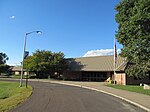Forty Acres and Its Skirts Historic District
Hadley, MassachusettsHistoric districts in Hampshire County, MassachusettsHistoric districts on the National Register of Historic Places in MassachusettsNRHP infobox with nocatNational Register of Historic Places in Hampshire County, Massachusetts ... and 1 more
Use mdy dates from August 2023

The Forty Acres and Its Skirts Historic District is a rural historic district along the Connecticut River in Hadley, Massachusetts. Located north of the town center on River Road, the district is a rural landscape with a well-documented history of settlement and usage from the mid-18th century into the 20th century. It includes the Porter-Phelps-Huntington House and adjacent properties, which have been home to a succession of prominent local families. The district was listed on the National Register of Historic Places in 2023.
Excerpt from the Wikipedia article Forty Acres and Its Skirts Historic District (License: CC BY-SA 3.0, Authors, Images).Forty Acres and Its Skirts Historic District
River Drive,
Geographical coordinates (GPS) Address Nearby Places Show on map
Geographical coordinates (GPS)
| Latitude | Longitude |
|---|---|
| N 42.368888888889 ° | E -72.585277777778 ° |
Address
River Drive 126
01035
Massachusetts, United States
Open on Google Maps










